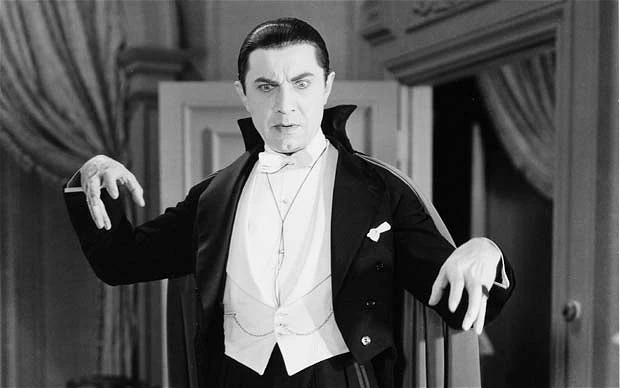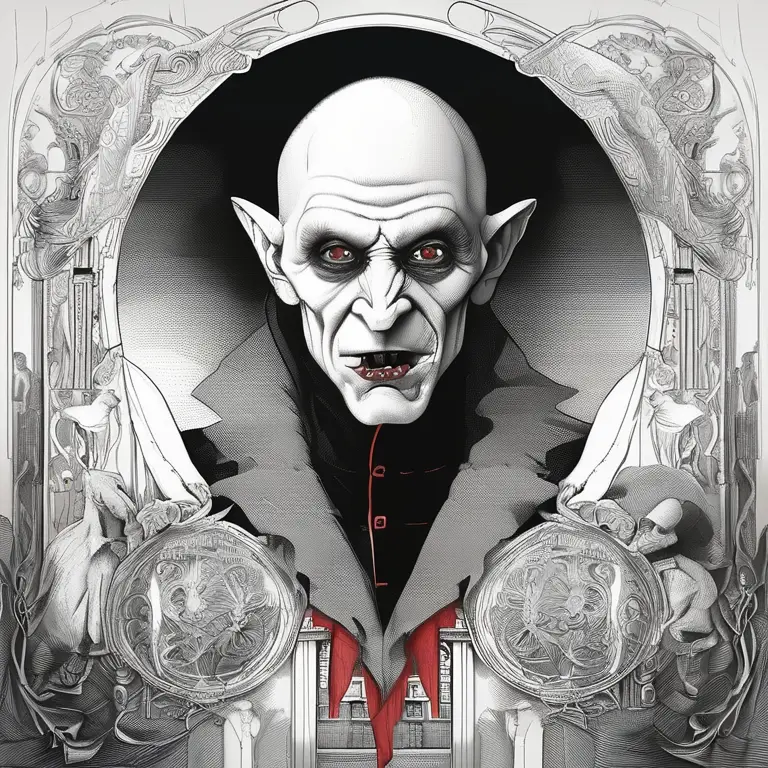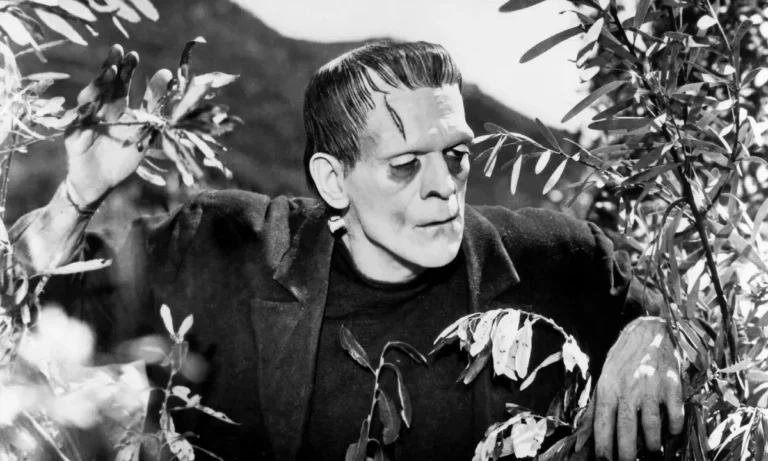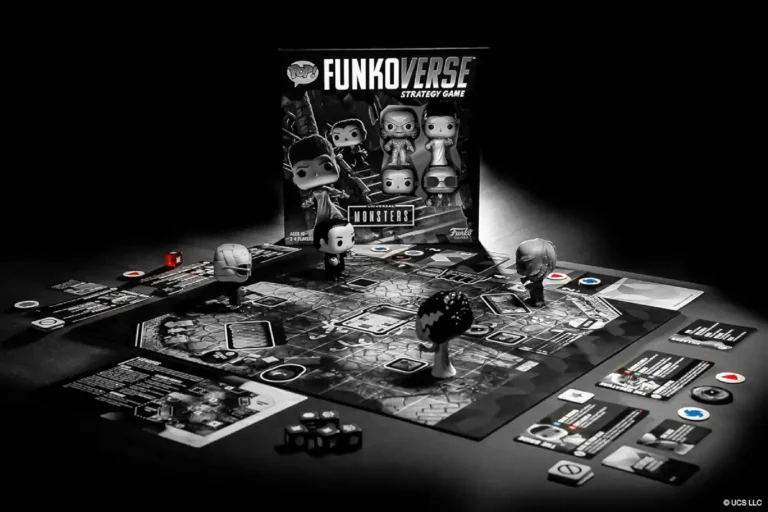Halloween Monsters: From Classics to Today
Halloween Today wouldn’t be the same without its legendary lineup of monsters. From the eerie shadows of classic horror to the terrifying creatures of modern nightmares, these ghouls, ghosts, and beasts have haunted our imaginations.
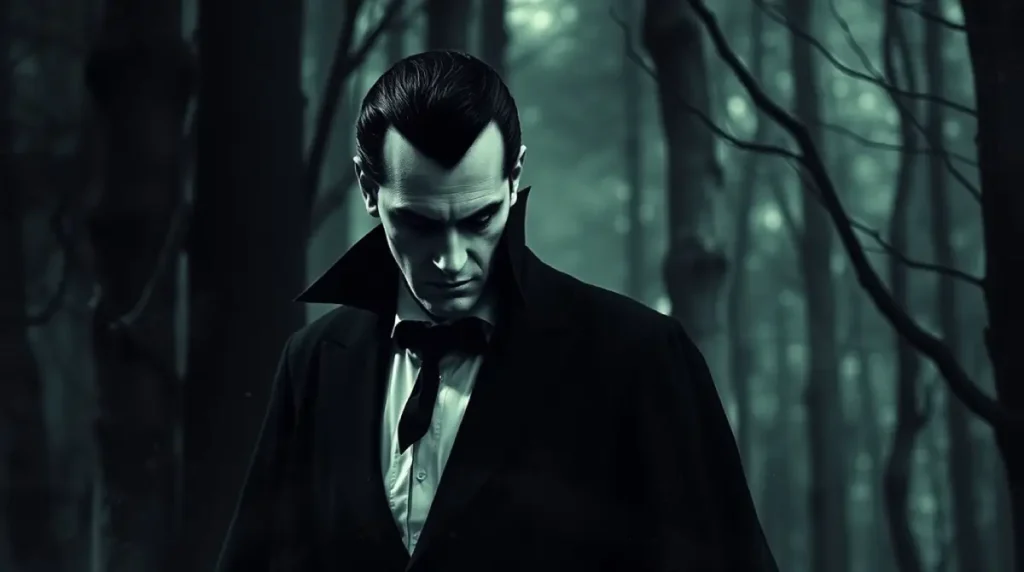
Whether you love the timeless frights of old-school horror films or the spine-chilling villains of today’s pop culture, this is the evolution of Halloween’s most iconic monsters.
Classic Halloween Monsters: The Legends That Started It All
Before CGI and high-budget special effects, horror thrived on eerie performances, dramatic lighting, and unforgettable creature designs. These classic monsters laid the foundation for all the spooky characters that followed.
Dracula – The Timeless Vampire
Bram Stoker’s Dracula (1897) introduced the world to the most famous vampire of all time. However, it was Bela Lugosi’s performance in Dracula (1931) that cemented the image of the sophisticated yet bloodthirsty count. With his slicked-back hair, elegant cape, and hypnotic stare, Dracula remains the ultimate symbol of gothic horror.
Frankenstein’s Monster – A Tragic Creation
Mary Shelley’s Frankenstein (1818) gave birth to one of literature’s most enduring creatures, but Boris Karloff’s portrayal in Frankenstein (1931) made him an icon. With his towering frame, flat head, and bolts in his neck, the misunderstood monster embodies both horror and heartbreak, reminding us that sometimes, the true monsters are those who reject the outcasts.
The Werewolf – The Beast Within
Bram Stoker’s Dracula (1897) introduced the world to the most famous vampire of all time. However, it was Bela Lugosi’s performance in Dracula (1931) that cemented the image of the sophisticated yet bloodthirsty count. With his slicked-back hair, elegant cape, and hypnotic stare, Dracula remains the ultimate symbol of gothic horror.
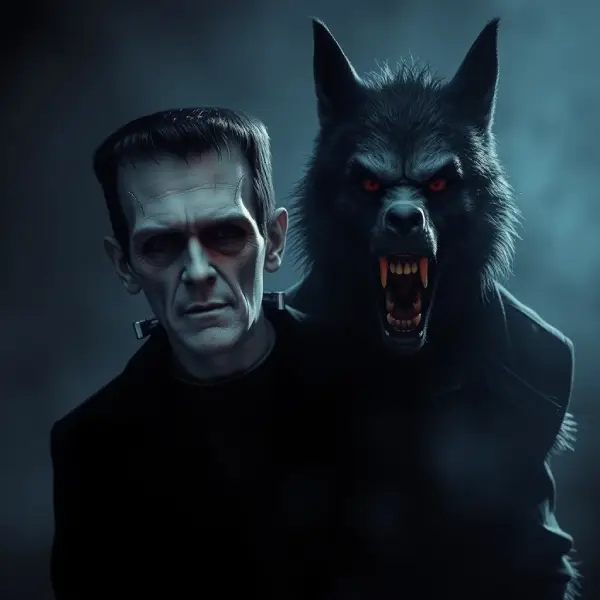
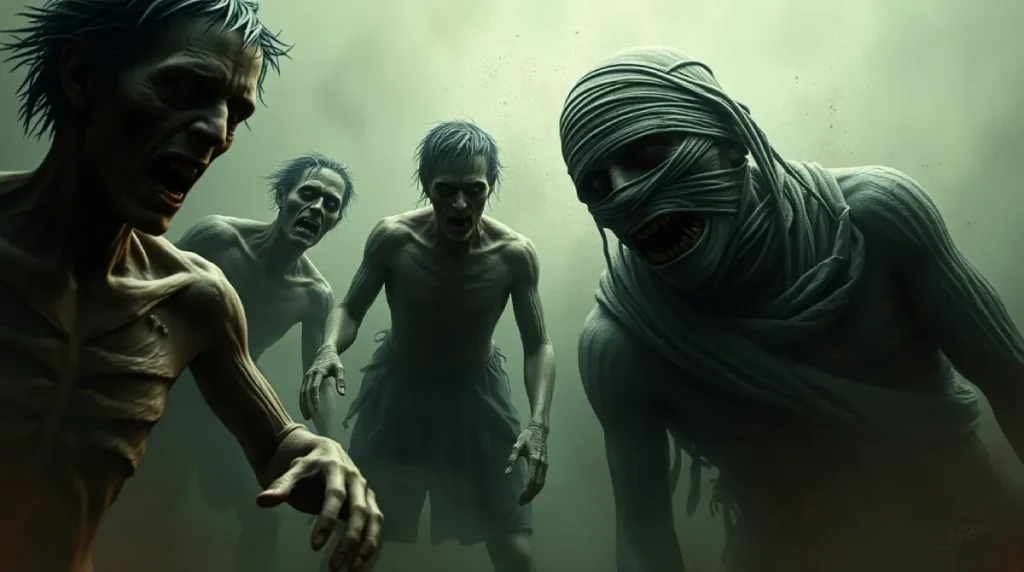
The Mummy – An Ancient Curse Unleashed
When Boris Karloff donned the bandages in The Mummy (1932), he introduced audiences to a new kind of terror—one wrapped in ancient Egyptian mythology. The idea of a vengeful mummy rising from the grave to seek revenge still influences modern horror films and stories.
Zombies – The Dead Don’t Rest
The zombies in I Walked with a Zombie (1943) are far from the flesh-eating ghouls of modern horror. Inspired by Haitian voodoo folklore, these undead figures are eerie, silent, and entranced, moving through the film like lost souls trapped between life and death. Unlike later zombie films that focus on apocalyptic terror, this classic masterpiece creates horror through atmosphere and mystery, blending gothic romance with the unsettling power of the supernatural. The film’s haunting visuals and dreamlike tone make its depiction of zombies one of the most unique and chilling in cinematic history.
The Invisible Man – The Terror You Can’t See
H.G. Wells’ novel The Invisible Man (1897) inspired the 1933 film of the same name, featuring a scientist who turns himself invisible but loses his sanity in the process. His eerie, bandage-wrapped face and maniacal laughter make him one of the most unique classic monsters.
Count Orlok – The Most Terrifying Vampire
Nosferatu (1922) is one of the most haunting and influential horror films of all time, bringing the eerie Count Orlok to life with his gaunt figure, claw-like fingers, and shadowy presence. A silent-era masterpiece directed by F.W. Murnau, the film is an unauthorized adaptation of Dracula, yet its stark cinematography and chilling atmosphere set it apart as a unique and unsettling classic. Max Schreck’s portrayal of Orlok remains one of the most terrifying depictions of a vampire, proving that true horror doesn’t need words—it lingers in the darkness.
The Gill-Man – The Terror You Can’t See
The Creature from the Black Lagoon (1954) introduced one of cinema’s most iconic and tragic monsters—the Gill-man. Unlike other classic horror creatures, the Gill-man wasn’t a supernatural being but an ancient, amphibious predator lurking in the depths of the Amazon. With his webbed claws, scaly skin, and haunting, human-like eyes, he was both terrifying and strangely sympathetic. A product of mid-century fears about science and the unknown, the Creature remains a beloved figure in horror, blending beauty and terror in a way few monsters ever have.
Modern Halloween Monsters: Horror’s New Faces of Fear
As horror evolved, so did its monsters. The supernatural gave way to psychological terror, science-fiction nightmares, and grotesque creatures from beyond our world. These modern monsters have left their mark on pop culture, each bringing a new kind of terror to the screen.
Michael Myers – The Shape of Pure Evil
Halloween (1978) introduced audiences to Michael Myers, a silent, masked killer with an unrelenting presence. Unlike supernatural monsters of the past, Michael was terrifying because he was human—yet utterly unstoppable. His influence can be seen in countless slasher villains that followed.
Freddy Krueger – Nightmares Made Flesh
Wes Craven’s A Nightmare on Elm Street (1984) gave horror one of its most creative and terrifying villains. Freddy Krueger, with his burnt skin, razor-sharp glove, and twisted humor, haunts the dreams of his victims, making sleep itself a dangerous act.
Jason Voorhees – The Masked Slasher
Born from Friday the 13th (1980), Jason Voorhees evolved from a drowned child to an unstoppable hockey-masked killer. His brute strength, silent presence, and gruesome kills make him one of horror’s most enduring modern monsters.
Leatherface – The Maniac with a Chainsaw
Debuting in The Texas Chain Saw Massacre (1974), Leatherface is a brutal, relentless killer who wears masks made of human skin and wields a deafening chainsaw. Inspired by real-life murderer Ed Gein, Leatherface embodies the raw, chaotic terror of slasher horror, turning his rural Texas home into a nightmarish slaughterhouse.
Pennywise – The Nightmare Clown
Stephen King’s It (1986) brought one of the most disturbing horror icons to life—Pennywise the Dancing Clown. Whether in Tim Curry’s 1990 portrayal or Bill Skarsgård’s terrifying reinvention in It (2017), this shape-shifting entity preys on fear itself, proving that clowns will always have a place in our nightmares.
Art the Clown – The Silent Maniac
From Terrifier (2016), Art the Clown is a nightmarish figure with his unsettling black-and-white clown makeup, wide grin, and eerie silence. Unlike traditional slashers, Art’s kills are excessively gruesome, and his sadistic sense of humor makes him even more disturbing. He has quickly become a rising star in modern horror.
Leatherface – The Maniac with a Chainsaw
Debuting in The Texas Chain Saw Massacre (1974), Leatherface is a brutal, relentless killer who wears masks made of human skin and wields a deafening chainsaw. Inspired by real-life murderer Ed Gein, Leatherface embodies the raw, chaotic terror of slasher horror, turning his rural Texas home into a nightmarish slaughterhouse.
Ghostface – The Masked Slasher
Ghostface, the iconic masked killer from Scream (1996), redefined the slasher genre by blending horror with self-aware satire. Unlike other horror villains, Ghostface isn’t a single entity but a mantle taken up by multiple killers, making each film a fresh whodunit mystery. With a love for horror trivia and brutal attacks, Ghostface remains one of modern horror’s most enduring figures.
Pinhead – The Master of Pain
Clive Barker’s Hellraiser (1987) introduced audiences to Pinhead, the sadistic leader of the Cenobites. With his chilling voice, hooked chains, and philosophical approach to suffering, Pinhead is not just a villain—he’s a harbinger of agony. His disturbing design and eerie calmness make him one of horror’s most unique and unsettling figures.
Hellboy – The Demonic Hero
Unlike most horror monsters, Hellboy straddles the line between hero and beast. Created by Mike Mignola and brought to life in Hellboy (2004), this cigar-smoking, red-skinned demon fights against supernatural threats rather than causing them. With his massive Right Hand of Doom and sardonic wit, Hellboy proves that not all monsters are villains.
Betelgeuse – The Ghost with the Most
Michael Keaton’s portrayal of Betelgeuse in Beetlejuice (1988) gave us a hilarious yet unsettling character who thrives on chaos. A mischievous, crude, and unpredictable bio-exorcist, Betelgeuse blurs the line between comedy and horror, proving that monsters don’t always have to be terrifying to leave an unforgettable mark.
Sam – The Spirit of Halloween
Sam from Trick ‘r Treat (2007) may look like an innocent trick-or-treater in a burlap sack mask, but he is the embodiment of Halloween itself. With his childlike appearance hiding a monstrous form, Sam punishes those who break the holiday’s traditions, serving as both guardian and executioner of the spooky season’s spirit.
Deadites – The Possessed Demons
The Evil Dead franchise introduced us to the Deadites, grotesque, demonic entities unleashed by the Necronomicon. Unlike traditional zombies, Deadites taunt and toy with their victims, speaking in terrifying voices while possessing the living. Their chaotic, unpredictable nature makes them one of horror’s most relentless threats.
Samara – The Vengeful Spirit
Emerging from the depths of a cursed VHS tape, Samara from The Ring (2002) is one of the most terrifying ghosts in modern horror. With her long, black hair obscuring her face and her slow, unnatural movements, she crawls out of televisions to claim her victims. Samara’s eerie presence turned a simple videotape into a death sentence.
Chucky – The Doll from Hell
First appearing in Child’s Play (1988), Chucky is a seemingly harmless toy possessed by the soul of a sadistic killer. With his foul mouth, twisted sense of humor, and violent tendencies, Chucky transformed the innocent idea of a child’s doll into pure nightmare fuel. Over the years, he has become one of horror’s most beloved and feared figures.
Billy the Puppet – The Messenger of Terror
The Saw franchise introduced audiences to Billy the Puppet, the eerie, red-cheeked doll who delivers Jigsaw’s sinister messages. While not the true villain, Billy has become the terrifying face of Saw, appearing on his tricycle to inform victims of their gruesome fate. His chilling voice and the phrase “I want to play a game” have become iconic in horror.
The Pale Man – The Nightmare
One of Guillermo del Toro’s most unsettling creations, the Pale Man from Pan’s Labyrinth (2006) is a gaunt, sagging creature with eyes in the palms of his hands. Sitting motionless at a banquet table, he only moves when provoked—then mercilessly devours his prey. His grotesque, almost fairy-tale-like horror is a perfect example of del Toro’s signature blend of beauty and nightmare.
The Babadook – Fear That You Can’t Escape
The Babadook (2014) introduced audiences to one of the most chilling and psychologically haunting monsters of modern horror. Unlike traditional creatures, the Babadook isn’t a physical being—it’s a manifestation of grief, depression, and the fears that lurk in the shadows of the mind.
The Xenomorph – The Ultimate Alien Horror
H.R. Giger’s horrifying biomechanical nightmare, the Xenomorph, first terrified audiences in Alien (1979). Its grotesque design, acid blood, and relentless hunting instincts make it one of the most terrifying extraterrestrial monsters in film history. Blending horror with sci-fi, the Xenomorph remains a symbol of pure survival.
The Predator – The Ultimate Hunter
First appearing in Predator (1987), this extraterrestrial warrior is a perfect blend of sci-fi and horror. With advanced weaponry, cloaking technology, and a brutal code of honor, the Predator hunts humans for sport. Its terrifying mandibles and eerie clicking sounds have made it one of the most feared creatures in film history.
The Death Angels – Monsters of Silence
The terrifying blind creatures from A Quiet Place (2018) are a unique addition to horror, relying solely on sound to hunt their prey. Their grotesque, armored bodies and hypersensitive hearing make them an unstoppable force, turning silence into the ultimate survival strategy. The tension they create proves that sometimes, the scariest monsters are the ones that force us to change how we live.
The Demogorgon – A Stranger Things Sensation
Netflix’s Stranger Things (2016) introduced a new kind of monster that blends sci-fi with classic horror. The Demogorgon, with its eerie, flower-like mouth and extra-dimensional origins, quickly became a fan favorite, bringing back the creature-feature horror of the past.
Each of these monsters brings something unique to the horror landscape, proving that fear comes in many forms—from supernatural creatures to masked killers and extraterrestrial nightmares. As horror continues to evolve, new monsters will rise, but these icons will always haunt our imaginations. 🎃👻

